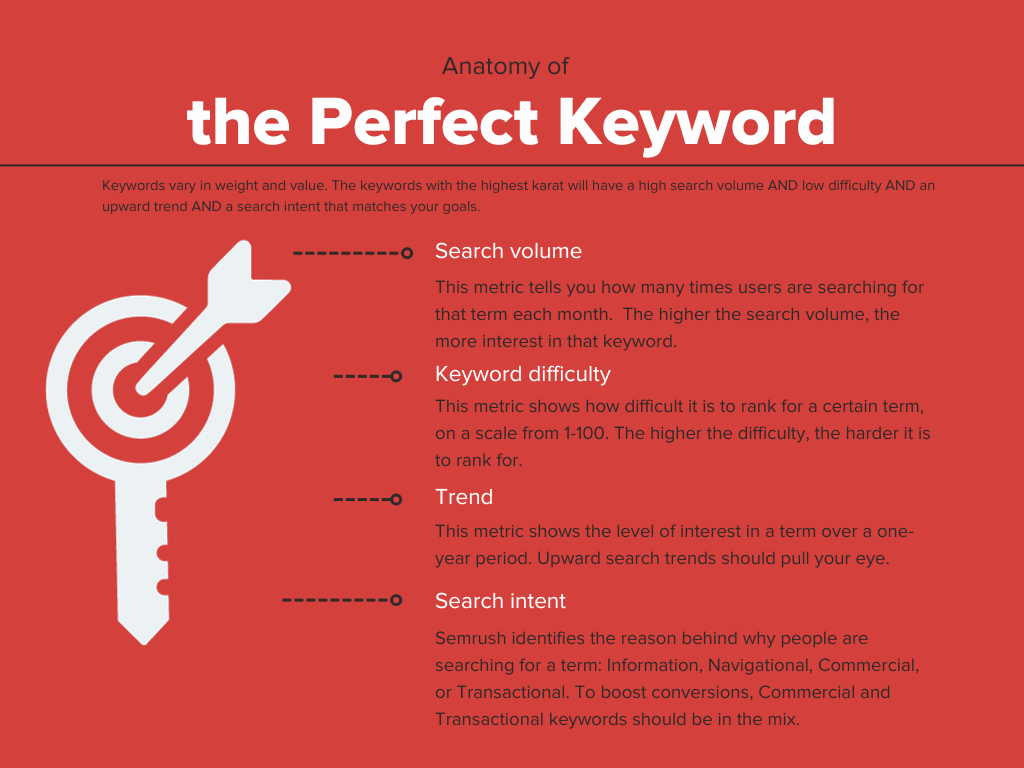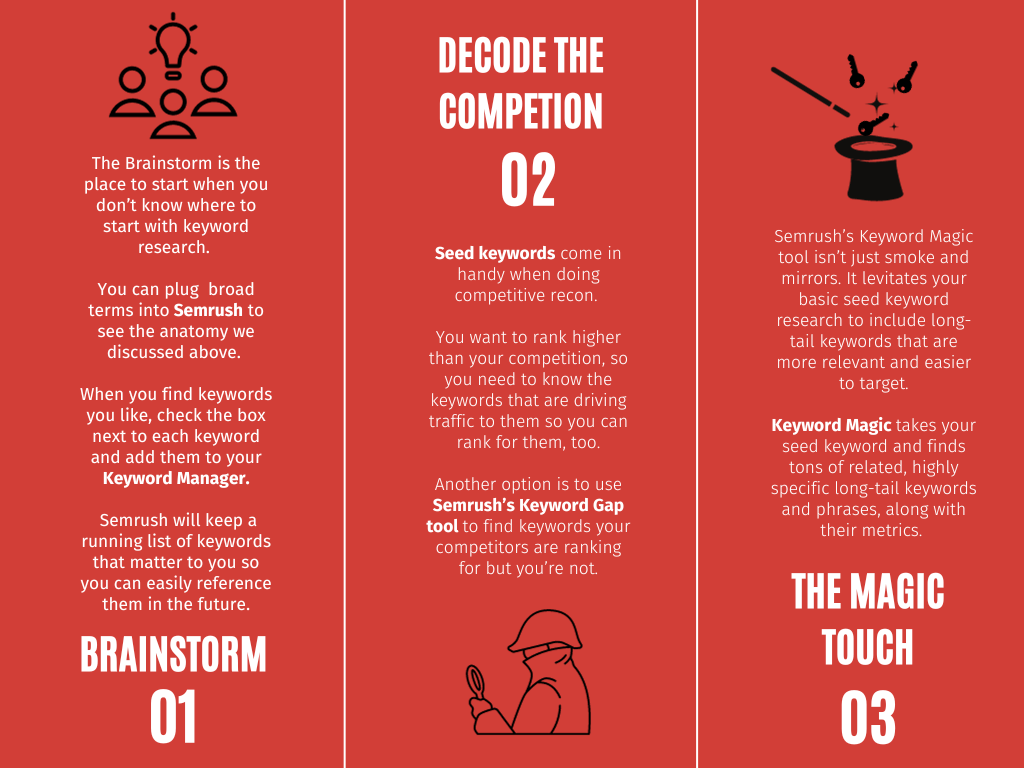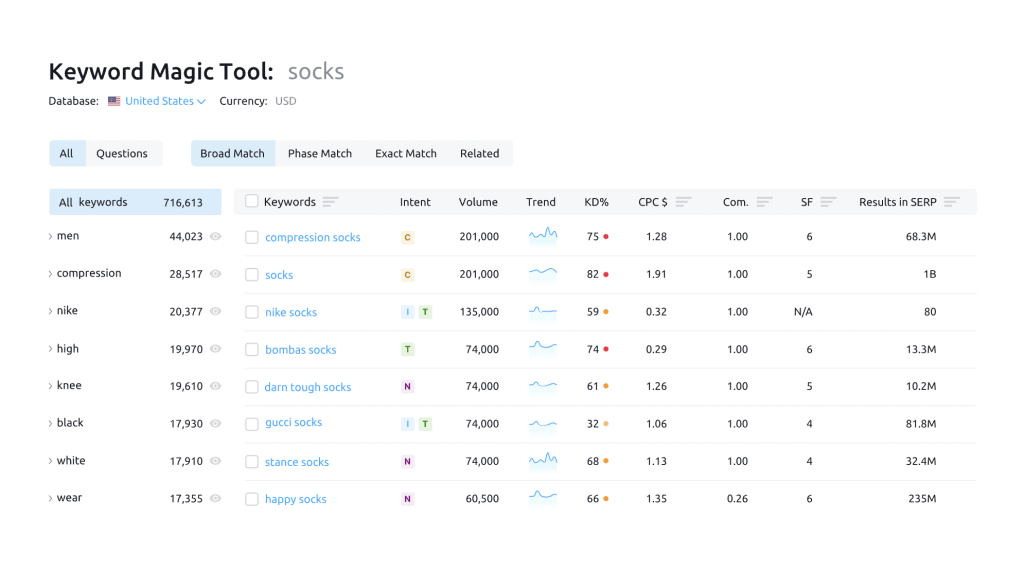Quick Links
There’s a good reason Semrush has nearly 500K active users–it’s one of the most in-depth, no-holds-barred keyword research tools around.
Content marketers can wield this mighty database of 25 billion keywords and their metrics to dominate the rankings.
Semrush gives you a secret peek behind the scenes of search that can help your content get ahead. It almost feels like cheating, until you realize this tool is so easy to access and use that anyone can do it–including your competitors.
But as with any tool, its power isn’t just in its inner workings but also your ability to harness it.
Here’s how you can do keyword research with Semrush to maximize your reach and drive more traffic.
Anatomy of the Perfect Keyword
Before we dive into specific keyword research methods, you need to be able to tell the difference between “keyword gold” vs. “keyword pyrite.”
We suggest prioritizing four key metrics, all of which you can find in Semrush:
- Search volume: This metric tells you how many times users are searching for that term each month. The higher the search volume, the more interest in that keyword.
- Keyword difficulty: This metric shows how difficult it is to rank for a certain term, on a scale from 1-100. The higher the difficulty, the harder it is to rank for.
- Trend: This metric shows the level of interest in a term over a one-year period. Upward search trends should pull your eye.
- Search intent: Semrush identifies the reason behind why people are searching for a term: Information, Navigational, Commercial, or Transactional. To boost conversions, Commercial and Transactional keywords should be in the mix.
Keywords vary in weight and value. The keywords with the highest karat will have a high search volume AND low difficulty AND an upward trend AND a search intent that matches your goals.
3 Methods for Semrush Keyword Research
Semrush gives you a 360-degree view of the keyword landscape, including the terms you’re already ranking for and new keywords to pursue.
For the purpose of this guide, we’re going to focus on three methodologies to find new keywords to add to your content strategy.
Method #1: The Brainstorm
The Brainstorm is the place to start when you don’t know where to start with keyword research. It’s like throwing keywords at a wall to see what sticks, and it’s easy to do.
Essentially, you’ll brainstorm obvious keywords related to your industry or content ideas and plug them into Semrush.
For example, let’s say you own a pest control company. You want to connect with people searching for pest control services, such as:
- Ant control
- Termites
- Spider pest control
Each of these can be considered “seed keywords” to start growing your Semrush keyword research.
You can plug these broad terms into Semrush to see the anatomy we discussed above.
When you find keywords you like, check the box next to each keyword and add them to your Keyword Manager. Semrush will keep a running list of keywords that matter to you so you can easily reference them in the future.
The Keyword Manager feature also creates keyword clusters around your topic. It automatically groups keywords based on topic or similarity, saving you time on your keyword research.
Now you have a list of keywords you can build your content around for more organic traffic.
This method works well for getting a quick snapshot of keywords. But you shouldn’t stop here. Seed keywords are usually very broad and competitive in nature, so combine this method with the other two methods we’ll discuss next.
Method #2: Decode the Competition
Seed keywords come in handy when doing competitive recon. You want to rank higher than your competition, so you need to know the keywords that are driving traffic to them so you can rank for them, too.
To do this, type a seed keyword into Google to find the most relevant results in your area.
Then, grab your rival’s URL and paste it into Semrush under Competitive Research > Organic Research.
Click View All Organic Keywords and boom—you’ve got some valuable business intelligence in the palm of your hand.
Another option is to use Semrush’s Keyword Gap tool to find keywords your competitors are ranking for but you’re not.
Plug in your website URL along with the URLs of a few of your competitors.
Semrush will give you a neat and tidy list of keywords to start targeting. Don’t forget to add them to Keyword Manager.
Method #3: The ‘Magic’ Touch
Semrush’s Keyword Magic tool isn’t just smoke and mirrors. It levitates your basic seed keyword research to include long-tail keywords that are more relevant and easier to target.
Broad terms like your seed keywords are likely to have a high search volume because people everywhere are searching for them.
They’re super competitive.
And even if you do rank for them, that doesn’t mean you’ll get in front of potential customers (unless you’re a national company, of course).
Keyword Magic takes your seed keyword and finds tons of related, highly specific long-tail keywords and phrases, along with their metrics.
Take advantage of the filter options, where you can refine results by Broad Match, Phrase Match, Exact Match, or Related Phrases.
You can also surface questions related to your keyword. These keywords can be powerful SEO juice since many users rely on search engines as a Q&A tool. They can also help you land rich snippets
You’ll also see key metrics displayed in the list. You can prioritize keywords based on Difficulty and Volume. It also tells you more about the search intent of each keyword to help you decide which keywords to focus on.
Run a Quick Keyword Analysis with Semrush–Start Here
There you have it—three different ways to do keyword research with Semrush. Each method builds on the next to help you extract the most value from your efforts, without investing much effort at all.
Try it for yourself—start your first keyword analysis on Semrush for free.












Thanks for the update